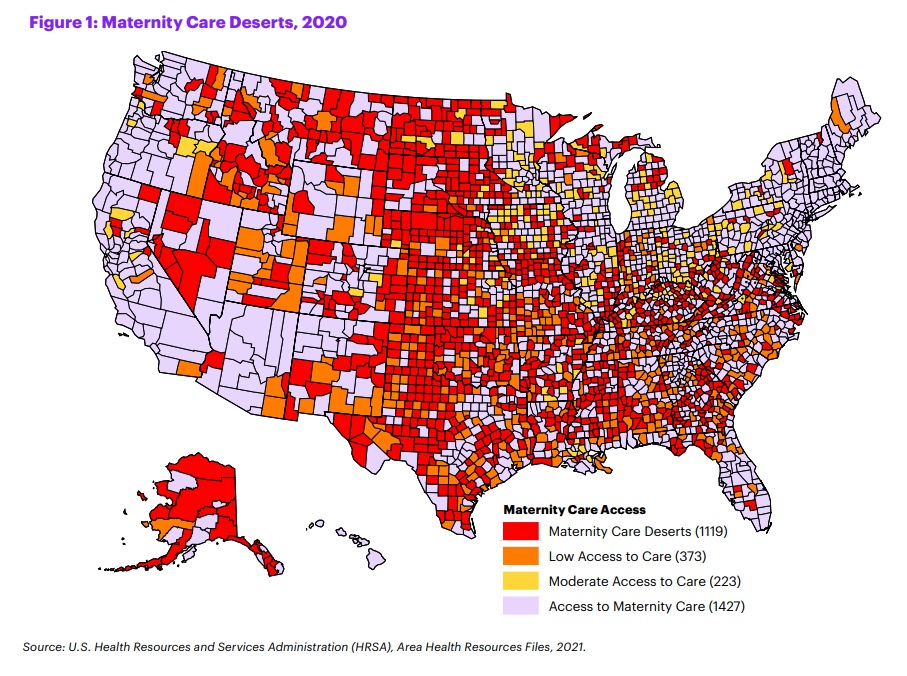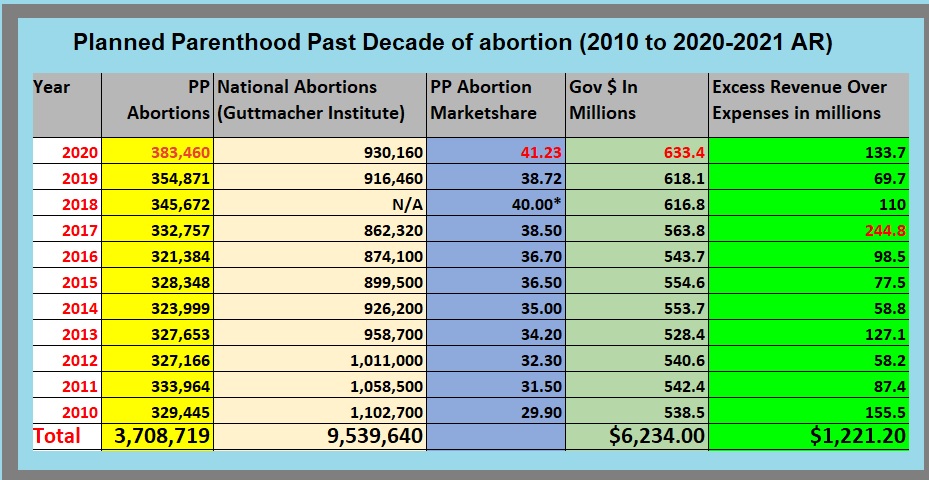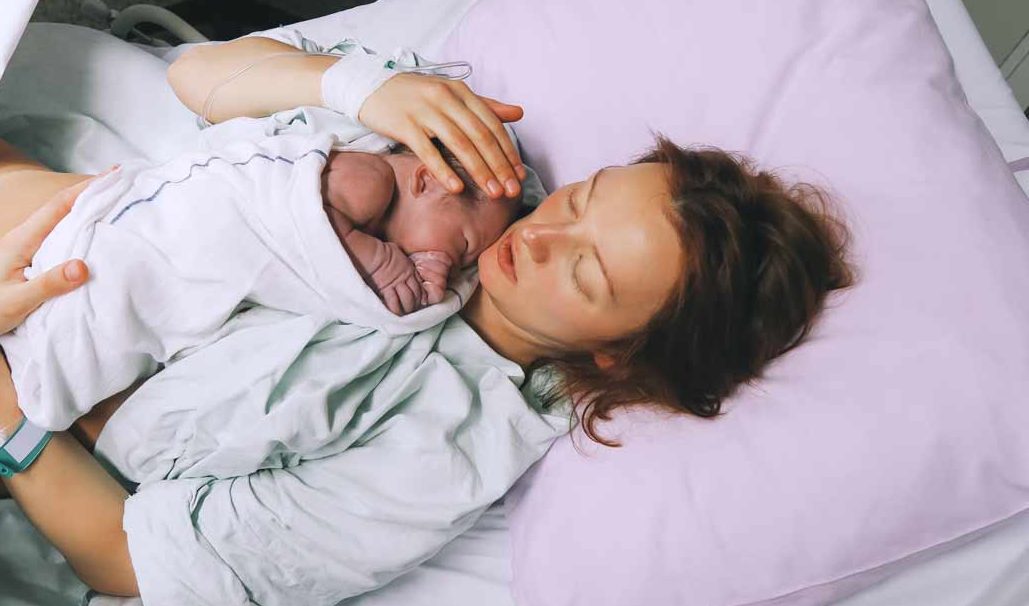A recently published March of Dimes report found that 36% of all US counties are “maternity care deserts.” The organization reported that “access to maternity care is diminishing in places where it’s needed most, impacting nearly seven million American women of childbearing age and roughly 500,000 babies.”

Maternity Care Deserts map from March of Dimes
The 2022 Maternity Care Deserts Report defines maternity care deserts as “counties without a hospital or birth center offering obstetrics care and without any obstetrics providers.”
It found that:
- 36% of counties across the U.S. are designated as maternity care deserts, counties with zero obstetric hospitals or birth centers and zero obstetric providers.;
- 2.2 million women of childbearing age live in maternity care deserts and more than 146,000 babies are born there;
- 5% of counties have a worse designation in this report than in the 2020 report;
- Nearly 7 million women are living in communities with no or limited access to maternity care. 1 in 8 babies are born in these areas;
- The loss of obstetric providers and obstetric services in hospitals were responsible for decreases in maternity care access in over 110 counties between this report and the 2020 report;
- 1 in 4 Native American babies were born in areas with no or limited access to maternity care services; and
- 1 in 6 Black babies were born in areas with no or limited access to maternity care services.
The report also stated, “Nationwide, five percent of counties have less maternity access than just two years ago. These areas of combined low or no access affect up to 6.9 million women and almost 500,000 births in the U.S. In maternity care deserts alone—approximately 2.2 million women of childbearing age and almost 150,000 babies are affected.” Previous reports have shown similar numbers.
Hospitals
“In 2020, 98.3 percent of all live births occurred in hospitals,” the report stated. That same year, “over eight million women of childbearing age lived in counties without an obstetric hospital.” In addition, it noted, “Overall, since 2005, 181 rural hospitals have closed across the country. […] The closure of maternity wards is concentrated in rural counties with the most frequent loss in the most remote counties.”
According to the pro-abortion American College of Obstetricians and Gynecologists, less than half of rural women live within a 30-minute drive to the nearest hospital offering perinatal services. In 2014, the organization explained, “Within a 60-minute drive, the proportion increases to 87.6% in rural towns and 78.7% in the most isolated areas.”
Despite this disparity, abortion advocates continue to prioritize abortion over actual health care. In New Mexico — where there is no gestational time limit on abortion and there are 11 maternity desert counties — rather than investing in rural maternity care hospitals, the governor there is focused on building a $10 million abortion facility. New York State politicians appear more interested in attacking pregnancy help centers, shielding abortionists from the consequences of their own dangerous actions, and making the state a “safe haven” for abortion, than they are in increasing maternity care access.
Birth centers and federally qualified health centers (FQHCs)
The March of Dimes report noted a slight increase in freestanding birth centers – which as of December 2021 stood at 406 nationwide. It also praised the work of federally qualified health centers (FQHCs), noting that these centers “provide a unique opportunity to improve maternal care in low-income communities.”
“As of December 2021, 8,104 FQHCs were identified” by the March of Dimes “as clinics that provide maternity care in the U.S.” But the report also noted, “Nearly half (48%) of rural counties don’t have an FQHC and at least 2.6 million Medicaid eligible women live in counties without an FQHC. […] Furthermore, over half (50.7%) of counties with no FQHC are maternity care deserts.”
Despite the fact that FQHCs provide a wide range of services for men, women, and children, rather than focusing on an increase in FQHCs, the pro-abortion media and its industry allies are fixated on attacking the positive free assistance offered at pro-life pregnancy help centers and expanding abortion to the point that the Biden Administration was even considering establishing abortion facilities (not maternity care centers) on federal land.
Abortion facilities offer women little “assistance” beyond abortion
The American public has been led to believe that abortion facilities provide needed medical care to women, but the report “Abortion service delivery in clinics by state policy climate in 2017” funded by an “anonymous donor” and published in the pro-abortion journal Contraception, tells a different story. The report used data from Planned Parenthood’s former “special affiliate,” the Guttmacher Institute, regarding all known US abortion facilities. It found that of the 808 abortion facilities categorized by Guttmacher as “clinics,” (which provided 95% of all abortions in 2017) just 27% offered general health care, and only 18% offered any type of prenatal and/or obstetric care.
Out of those categorized as “specialized abortion clinics” — which commit 60% of abortions — only 11% offered general healthcare and only 5% offered prenatal and/or obstetric care.
In the “nonspecialized clinics” category — which commits 35% of all abortions — only 36% offer general healthcare and 25% offer some kind of obstetric or prenatal care.
Planned Parenthood v FQHCs
Planned Parenthood provides an estimated 1% or less of prenatal care services in the U.S. and commits 43 abortions for every one prenatal care service it provides. Yet, pro-abortion politicians continue to fund this organization to the tune of $618.1 million last year alone — $9.3 billion since 2000.
Planned Parenthood’s most recent report revealed that while prenatal care at Planned Parenthood increased just 2% (from 8,626 in 2019 to 8,775 in 2020), the service has decreased drastically in the past decade, falling nearly 72% from 31,098 prenatal services reported in 2010.
Planned Parenthood offers substantially fewer prenatal care services to women than do FQHCs:
- 2015: While PP recorded 9,419 prenatal services, FQHCs served 552,150 prenatal patients.
- 2016: While PP recorded 7,762 prenatal services, FQHCs served 559,848 prenatal patients.
- 2017: While PP recorded 9,055 prenatal services, FQHCs served 573,026 prenatal patients.
- 2018: While PP recorded 9,798 prenatal services, FQHC’s served 563,740 prenatal patients.
- 2019: While PP recorded 8,626 prenatal services, FQHC’s served 583,328 prenatal patients.
- 2020: While PP recorded 8,775 prenatal services, FQHC’s served 551,990 prenatal patients.
Yet, within this same timeframe (2015-2020), Planned Parenthood committed over 2 million abortions.

Planned Parenthood past decade: abortions, market share. Gov dollars. excess revenue (2000 to 2020-2021 AR)
Planned Parenthood served approximately 2.4 million clients annually between 2015 to 2019, dropping to approximately 2.2 million clients in 2020.
In contrast:
- 2015: FQHCs served 24,295,946 clients
- 2016: FQHCs served 25,860,296 clients
- 2017: FQHCs served 27,174,372 clients
- 2018: FQHCs served 28,379,680 clients
- 2018: FQHCs served 29,836,613 clients
- 2018: FQHCs served 28,590,897 clients
Likewise, while Planned Parenthood facilities have remained at around 600 locations (2017 to 2020), FQHC’s number of sites grew from 10,400 in 2017 to 13,500 in 2021.
Companies scale back on maternity benefits and fund abortion travel
Despite the disparity in maternal healthcare facilities, corporate America – which could pour its dollars into life-affirming solutions — is by and large pushing abortion. A recent Wall Street Journal (WSJ) survey of 3,000 employers found that only 35% now offer paid maternity leave benefits beyond what is mandated by federal law, down from 53% in 2020. Yet, pro-abortion corporate America is tripping over itself to fund abortion travel.
As reported previously by Live Action News, a Washington Examiner report found there are over 120 major corporations including Apple, Tesla, Disney, Hulu, Microsoft, Kroger, and Dick’s Sporting Goods providing unique abortion benefits to employees. Netflix has offered each employee a $10,000 lifetime allowance for abortion-related travel.
Women deserve life-affirming solutions to critical healthcare shortages. What they don’t need are unregulated virtual and mobile abortion options, and chemical abortion pills. It is past time for policymakers to pivot from abortion advocacy to building real healthcare options for women.








